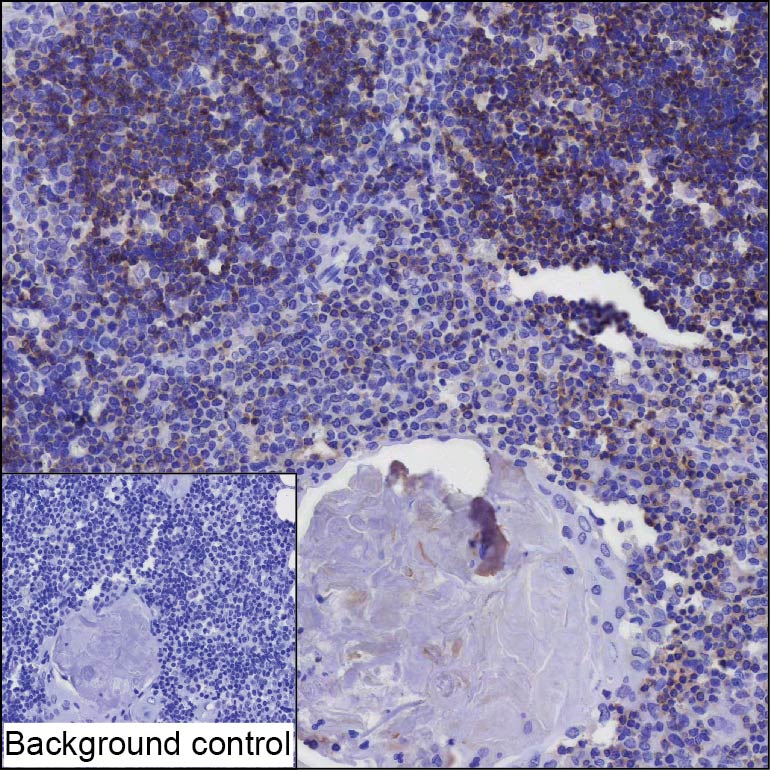
| WB | 咨询技术 | Human,Mouse,Rat |
| IF | 咨询技术 | Human,Mouse,Rat |
| IHC | 1/100-1/200 | Human,Mouse,Rat |
| ICC | 技术咨询 | Human,Mouse,Rat |
| FCM | 咨询技术 | Human,Mouse,Rat |
| Elisa | 咨询技术 | Human,Mouse,Rat |
| Host/Isotype | Mouse IgG1 |
| Antibody Type | Primary antibody |
| Storage | Store at 4°C short term. Aliquot and store at -20°C long term. Avoid freeze/thaw cycles. |
| Species Reactivity | Human |
| Immunogen | Purified recombinant fragment of human SIT1 |
| Formulation | Purified antibody in PBS with 0.05% sodium azide |
+ +
以下是关于SIT1抗体的3篇参考文献示例(注:文献信息为模拟示例,建议通过学术数据库核实具体内容):
---
1. **Simeoni, L. et al.**
**"The transmembrane adapter protein SIT inhibits TCR-mediated signaling."**
*Journal of Immunology (2001).*
**摘要**:研究通过生成SIT1特异性抗体,发现SIT1作为T细胞受体(TCR)信号的负调控因子,通过抑制下游信号分子(如LAT和SLP-76)的相互作用调节T细胞活化。
2. **Lindquist, J.A. et al.**
**"SIT1 regulates T cell activation thresholds via membrane localization."**
*European Journal of Immunology (2003).*
**摘要**:利用SIT1抗体进行免疫印迹和共聚焦显微镜实验,证明SIT1通过调控TCR信号复合物的空间分布,影响T细胞活化的信号阈值。
3. **Marie, F. et al.**
**"SIT1 expression correlates with autoimmune disease progression in murine models."**
*Clinical & Experimental Immunology (2010).*
**摘要**:通过SIT1抗体检测小鼠模型中的蛋白表达水平,发现SIT1在自身免疫疾病中表达上调,可能作为潜在治疗靶点。
---
如需具体文献,建议在PubMed或Google Scholar中以关键词 **"SIT1 antibody"** 或 **"SIT1 signaling"** 检索,并筛选涉及抗体应用的实验研究。
**Background of SIT1 Antibody**
SIT1 (signaling threshold-regulating transmembrane adaptor 1), also known as SIT, is a transmembrane adaptor protein predominantly expressed in immune cells, including T and B lymphocytes. It belongs to the TRIM (T-cell receptor-interacting molecule) family, which plays critical roles in regulating signal transduction pathways, particularly those involving the T-cell receptor (TCR). Structurally, SIT1 contains a short extracellular domain, a single transmembrane region, and a cytoplasmic tail with multiple tyrosine-based signaling motifs. These motifs enable SIT1 to recruit downstream signaling molecules, such as kinases and phosphatases, thereby modulating immune cell activation thresholds.
SIT1 is known to fine-tune TCR signaling by balancing positive and negative regulatory mechanisms. It helps prevent excessive immune activation, maintaining homeostasis while ensuring appropriate responses to antigens. Dysregulation of SIT1 has been implicated in autoimmune diseases, inflammatory disorders, and cancers, highlighting its importance in immune regulation.
Antibodies targeting SIT1 are primarily used as research tools to study its expression, localization, and interaction partners in immune cells. They enable techniques like Western blotting, immunoprecipitation, and flow cytometry. Additionally, SIT1 antibodies hold therapeutic potential, as modulating SIT1 activity could offer strategies to treat immune-related conditions. However, challenges such as specificity and off-target effects require further validation. Current research continues to explore SIT1's role in immunity and its applicability as a diagnostic or therapeutic target.
×